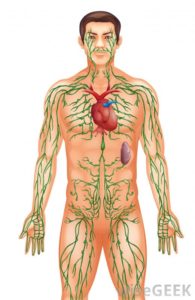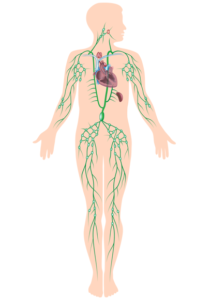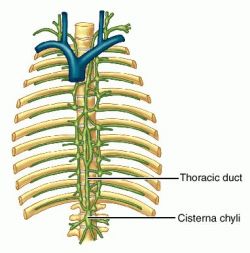Lymphatic system
To work on the cysternii/’cement pole’ in the Maya /Arvigo system:
 Backing up a bit . .
Backing up a bit . .
The lymphatic system has many functions and is an essential component of the body. First and foremost, its main function is to maintain fluid and protein balance within the body. This intricate system returns excess tissue fluid to the blood, and it absorbs fats and vitamins from the digestive tract to deliver them to the circulatory system. It also is most well-known for being part of the immune system, because it acts as a defense mechanism against invading microorganisms and disease.
The lymphatic system is necessary, as it is the network that moves fats throughout the body. Lymphatic vessels deliver lymph from capillaries into large veins in the neck, where then lymph is coursed into the bloodstream and delivered to the heart. Throughout this closed system, there are lymph glands strategically placed within the vessels that filter through the lymph as it traverses through the system. About 10 percent of the fluid in the blood that is filtered by capillaries, along with proteins, becomes trapped in the tissues of the body. This loss of fluid would otherwise be life threatening, but the lymphatic system returns it to the circulatory system, where the cisterna chyli holds it before it is returned to the bloodstream.
The lymphatic system is associated with the health and function of many areas the body, including the digestive system and various organs such as the spleen and thymus, as well as bone marrow. If a lymphatic insufficiency of the internal organs develops, it could lead to various lymphatic system diseases. These might include cancers such lymphoma and auto-immune diseases such as arthritis or scleroderma, to name a few.
The location of the (red) spleen organ . .

Why the Spleen?
Seen as a disposable organ, this in all Asian medicine is the function of the spleen (red blood call storage plus the lymphatic master) and the pancreas – the sweet issue – and of course diabetes. . inflammation – excess sweet (and shock).
All I say on the cold storage – stopping circulation – Yang Qi is to be remembered here. Fluid where it is not to be? Lack of iodine availability – meaning you may have it enough BUT the halides and the heavy metals blocking the selenium (if it is there – again a trial with modern farming methods and the us of alumnium in all products – even therapeutic – as though it were not only nerurotoxic but also hinders normal biochemical transfer of nutrients at a cellular level).
cis·ter·na chy·’li
A dilated sac at the lower end of the thoracic duct into which the intestinal trunk and two lumbar lymphatic trunks open; it occurs inconsistently and when present is located posterior to the aorta on the anterior aspect of the bodies of the first and second lumbar vertebrae.
Synonym(s): chyle cistern ☆ , ampulla chyli, chylocyst, Pecquet cistern, Pecquet reservoir, receptaculum chyli, receptaculum pecqueti


Cisterna chyli Appearance
It is a large vessel that measures approximately 6 cm (2.4 inches) in length.
Cisterna chyli Function
It receives and temporarily stores lymph, the clear body tissue fluid, as it traverses upwards the body. It is one of the two reservoirs that contain lymph as well as other bodily fluids that can be found in the lymphatic system.
ANATOMY
Cisterna Duct is located in the Lumbar region of the abdominal Cavity. It is a common drainage trunk for the body’s lymphatic. It traverses to the lower body from the upward body. Situated to the right of the Abdominal Aorta at the back wall of the Abdominal Cavity, it is a large vessel. Its length is about 6cm. There it forms the Primary Lymph Vessels, the Thoracic Duct, which transports lymph and Chyle (milky bodily fluids, emulsified fats and non fatty acids) from abdomen to the junction of left Subclavian Vein (paired large vein on either sides of body) and Internal Jugular Veins (paired veins collecting blood from brain and some part of face and neck) through Aortic opening of the Diaphragm.

FUNCTION
Cisterna Chyli is one of the two reservoirs holding lymph and other bodily fluids found in lymphatic system. It receives and temporarily stores the lymph and body tissue fluids as it traverses upward body.
http://www.wisegeekhealth.com/what-is-the-cisterna-chyli.htm#
The cisterna chyli is a small, dilated sac found near the lower area of the thoracic duct in the lumbar region of the body’s abdominal cavity. It is part of the lymphatic system and is the sac that acquires and temporarily holds lymph, the clear fluid from the body’s tissues, as it traverses from the lower body on upward. Located to the right of the abdominal aorta at the back wall of the abdominal cavity, the structure is a large vessel, about 2.4 inches (6 cm) in length.
The thoracic duct begins in the mid-gut area, from the union of the right and left lumbar trunks with the intestinal trunk. This union creates the pathway known as the cisterna chyli, which receives lymph fluid from the intestinal truck and the left and right lumbar lymph trunks. The thoracic duct collects the lymph and delivers it to the bloodstream.
The cisterna chyli is one of two reservoirs that hold lymph and other bodily fluids that are found in the lymphatic system. Along with the cisterna chyli, there is also the cisterna subarachnoidea. This sac, however, plays an integral role, because it is responsible for collecting lymph and acting as a drainage point for “white fat” from the digestive organs.
cisterna
[sis-ter´nah] (pl. cister´nae) (L.)
cisterna cerebellomedulla´ris poste´rior the enlarged subarachnoid space between the undersurface of the cerebellum and the posterior surface of the medulla oblongata; called also cisterna magna.
cisterna chy´li the dilated portion of the thoracic duct at its origin in the lumbar region; called also receptaculum chyli.
cisterna mag´na c. cerebellomedullaris posterior.
https://www.ajronline.org/doi/full/10.2214/ajr.175.5.1751462
“The cisterna chyli is the dilated origin of the thoracic duct, which receives the right and left lumbar lymphatic trunks and the intestinal lymphatic trunk. In 1996, Gollub and Castellino [1] first described its appearance on CT: the cisterna chyli appears as a retrocrural tubular structure of near-water attenuation and is located to the right of the aorta and anterior to the vertebral bodies between T11 and L1. The cisterna chyli may be located to the left of the aorta.
Also see here for extra rib and the compression that may cause issues.
ALSO SEE . . .
Interstitium (‘new’ discovery)
The interstitium is a contiguous fluid-filled space existing between a structural barrier, such as a cell wall or the skin, and internal structures, such as organs, including muscles and the circulatory system.
Functions. The interstitial fluid is a reservoir and transportation system for nutrients and solutes distributing among organs, cells, and capillaries, for signaling molecules communicating between cells, and for antigens and cytokines participating in immune regulation.
All the Stuck Liver Qi work and flank gouge and butt work can only help.
